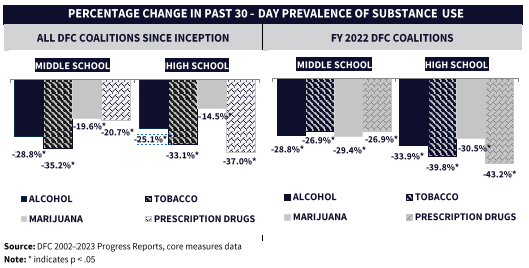Drug-Free Communities Support Program
Created in 1997, the Drug-Free Communities (DFC) Support Program funds community-based coalitions that engage multiple sectors of the community to prevent youth substance use.
The DFC Support Program provides grants up to $125,000 per year for five years to community coalitions to strengthen the infrastructure among local partners to create and sustain a reduction in local youth substance use. After five years, community coalitions may re-compete for another five-year cycle.
Recognizing that local problems need local solutions, DFC-funded coalitions engage multiple sectors of the community and employ a variety of environmental strategies to address local substance use problems. DFCs involve local communities in finding solutions and also helps youth at risk for substance use recognize the majority of our nation’s youth choose not to use substances. As demonstrated by independent evaluations, the DFC Support Program significantly reduces substance use amongst youth, the target population.
DFC Coalitions consist of community leaders representing twelve sectors that organize to meet the local prevention needs of the youth and families in their communities. These twelve sectors are:
- Youth
- Parents
- Businesses
- Media
- School
- Youth-serving organizations
- Law enforcement
- Religious/fraternal organizations
- Civic and volunteer organizations
- Healthcare professionals
- State, local, and Tribal governments
- Other organizations involved in reducing illicit substance use
By funding these coalitions, the DFC Support Program ensures communities adopt a balanced and comprehensive approach to reducing substance use in their neighborhoods.
Since the program’s inception, the past 30-day prevalence of alcohol, tobacco, marijuana, and prescription drug misuse has declined significantly among middle school and high school aged youth.
Decreasing youth substance use: Youth substance use significantly decreases in communities with a DFC coalition. The graphs below show the percentage of students in communities with a DFC coalition who reported they had not used a drug in the past 30 days.

In addition to the substances listed above, most DFC coalitions (73%) reported that they implemented activities to address opioids and/or methamphetamine.
Reaching youth across the country: An estimated 75 million people (23% of the U.S. population) lived in communities served by DFC coalitions receiving funding in 2023. This included approximately 3 million middle school youth ages 12 to 14 (23% of all middle school youth) and about 4 million high school youth ages 15 to 18 (23% of all high school youth).By funding coalitions in all 50 states, the District of Columbia, and three United States territories (Guam, Puerto Rico, and Virgin Islands), the DFC Support Program helps youth across the country and of all demographics to stay healthy and safe.
Funding comprehensive solutions to youth substance use: By requiring representation from each of the 12 sectors, the DFC Support Program helps mobilize approximately 43,000 community members representing everything from youth groups to local media, religious/fraternal organizations to the private sector, and law enforcement (including ONDCP’s High Intensity Drug Trafficking Areas) to educational institutions. This diversity in membership helps coalitions connect their communities’ resources to each other and develop comprehensive, evidence-based prevention programming.
Read more about the DFC Support Program’s impact in the 2023 End of Year National Evaluation Report.
The Comprehensive Addiction and Recovery Act (CARA) Community Based Coalition Enhancement of Grants to Address Local Drug Crises Grants (CARA Local Drug Crises Grants) program is aimed at current or former Drug-Free Communities Support Program grant recipients to prevent and reduce the use of opioids or methamphetamines and the misuse of prescription medications among youth ages 12-18 in communities throughout the United States.
CARA Local Drug Crises Grants are funded and directed by ONDCP in partnership with the Department of Health and Human Services (HHS), Centers for Disease Control and Prevention (CDC), National Center for Injury Prevention and Control (NCIPC) for the day-to-day management of the program. The CARA Grants program was established by the Comprehensive Addiction and Recovery Act of 2016 (Public Law 114-198).
